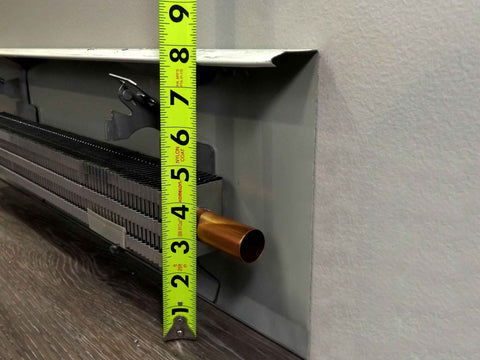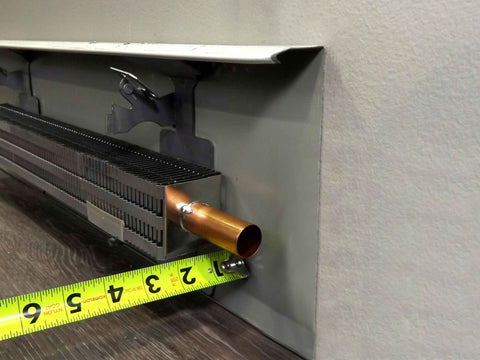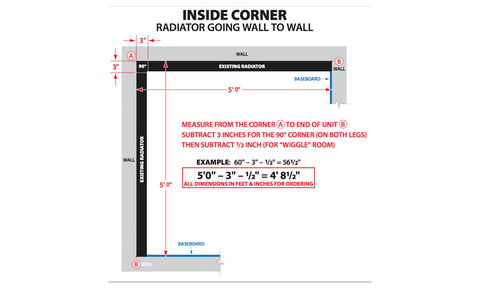Baseboard heaters offer zone heating control, quiet operation, and relatively simple installation compared to other heating systems. However, not all baseboard heaters work the same way.
Whether you’re building a home, renovating, or replacing an old heating system, selecting the right baseboard heater will impact your comfort, energy bills, and home’s overall efficiency. This guide breaks down the main types of baseboard heaters, explains how each design works, and helps you determine which option might work best for your home.
Hydronic Baseboard Heaters
Hydronic baseboard heaters, also called hot water baseboard heaters, use heated water to warm the home. The system connects to a central boiler that heats water and circulates it through pipes to individual baseboard units.
How Hydronic Baseboard Heaters Work
A central boiler heats water using natural gas, oil, or electricity. The heated water flows through pipes to baseboard units in each room. Inside each unit, the hot water passes through metal fins or tubes that transfer heat to the surrounding air. The cooled water returns to the boiler for reheating and recirculation.
Advantages of Hydronic Baseboard Heaters
-
- Decreased operating costs: Natural gas and oil are typically cheaper than electricity-based heating systems.
-
- Even heat distribution: Water retains heat longer than air, providing more consistent temperatures.
-
- Comfortable warmth: Hydronic baseboard heaters create gentle, radiant heat that feels natural.
-
- Quiet operation: No fans or electrical heating elements are necessary for hydronic heaters.
-
- Zoned heating: Users can control the temperature level in areas independently.
Disadvantages of Hydronic Baseboard Heaters
-
- High installation costs: Hydronic baseboard heaters require a boiler, pipes, and professional installation.
-
- Complex maintenance: The boiler and water systems need regular servicing.
-
- Slower response time: It can take longer than ideal to adjust a room’s temperature.
-
- Risks of leaks: Water-filled systems can develop leaks over time
Convection Baseboard Heaters
Convection baseboard heaters rely on air movement to distribute heat throughout a room. While most baseboard heaters use some convection, these units are specifically designed to maximize air circulation.
How Convection Baseboard Heaters Work
Convection units heat air that flows through the heater housing. The heated air rises and creates a circulation pattern that moves warm air throughout the room. Some convection heaters include small fans to boost air movement, while others rely on natural air circulation.
Fan-Assisted vs. Natural Convection
Fan-assisted convection heaters use small, quiet fans to move air through the heating elements more quickly. This allows for faster heating and better air circulation, but it requires electricity to run the fan.
Natural convection heaters rely entirely on the natural rising of warm air to create circulation. These units operate completely silently but may heat rooms more slowly.
Radiant Baseboard Heaters
Radiant baseboard heaters work differently from convection units. Instead of heating the air, they emit infrared heat that directly warms objects and people in the room.
How Radiant Baseboard Heaters Work
Radiant heaters use heating elements that emit infrared radiation. This invisible heat energy travels through the air and warms whatever it touches—furniture, walls, floors, and people. The warmed objects then release heat back into the room, creating comfortable ambient temperatures.
Benefits of Radiant Heat
-
- Immediate warmth: People can feel the heat as soon as the unit turns on.
-
- Energy efficient: The system uses less energy because it directly heats people and objects rather than heating air.
-
- No air movement: Radiant heat systems don’t stir up dust or allergens.
Combination Baseboard Heaters
Some baseboard heaters combine both convection and radiant heating methods. These hybrid units aim to provide the benefits of both heating types in a single system.
How Combination Heaters Work
Combination units typically use heating elements that both warm the air (convection) and emit infrared heat (radiant). This dual approach can provide faster initial heating from the radiant component and sustained warmth from the convection heating.
How To Choose the Best Baseboard Heater
Consider Your Budget
Electric baseboard heaters cost the least to purchase and install. Hydronic systems require the highest initial investment due to the cost of the boiler and pipes.
For operating the system, natural gas and oil typically cost less than electricity for heating. However, electricity prices vary significantly by region.
Evaluate Your Home’s Setup
A home’s existing infrastructure can affect which system will work the best without costing a fortune. Homes with natural gas lines can more easily accommodate hydronic systems. Consider what infrastructure you already have that might make one system easier to install than another.
Additionally, large homes or homes in cold climates may benefit from the efficiency of hydronic systems. Small homes or mild climates might work well with a simple heating system.
Usage Patterns
If you want to heat specific rooms only when needed, convection baseboard heaters offer more flexibility with zoned heating. On the other hand, hydronic systems work well for heating entire homes consistently.
Maintenance Requirements
Convection baseboard heaters require minimal maintenance beyond occasional cleaning. Hydronic systems need regular boiler maintenance and potential pipe repairs.
Enhance Your Baseboard Heater System
Regardless of which type you choose, you can improve your baseboard heater’s performance and appearance with quality covers and proper installation.
Modern baseboard heater covers can immensely improve heat distribution while updating your home’s look. Quality covers direct airflow more effectively and protect the heating elements from dust and debris.
When selecting baseboard replacement covers, look for durable materials that won’t rust or corrode over time. Steel covers with protective coatings offer the best longevity and performance.
Make the Right Choice for Your Home
The best baseboard heater type depends on your specific needs, budget, and home setup. When you understand the different types of baseboard heaters, you make the best choice for your home’s heating requirements.
Electric baseboard heaters work well for supplemental heating, room additions, or homes where installation simplicity matters most. Hydronic systems excel in cold climates where consistent, efficient heating is the priority.
Consider consulting with a heating professional to evaluate your home’s specific requirements. They can help you calculate heating loads, assess your electrical or gas capacity, and recommend the most cost-effective solution.
Remember that choosing the right baseboard heater is an investment in your home’s comfort and efficiency. Take time to research your options and select a system that will serve your needs for years to come.























